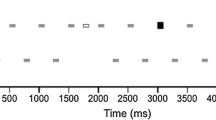Abstract
In this paper, we propose the application of the Kernel PCA technique for feature selection in high-dimensional feature space where input variables are mapped by a Gaussian kernel. The extracted features are employed in the regression problem of estimating human signal detection performance from brain event-related potentials elicited by task relevant signals. We report the superiority of Kernel PCA for feature extraction over linear PCA.
Access this chapter
Tax calculation will be finalised at checkout
Purchases are for personal use only
Preview
Unable to display preview. Download preview PDF.
Similar content being viewed by others
References
Trejo LJ, Shensa MJ. Feature Extraction of ERPs Using Waveletes: An Application to Human Performance Monitoring. Brain and Language 1999; 66:89–107.
Trejo LJ, Kramer AF, Arnold JA. Event-related Potentials as Indices of Display-monitoring Performance. Biological Psychology 1995; 40:33–71.
Koska M, Rosipal R, König A, Trejo LJ. Estimation of human signal detection performance from ERPs using feed-forward network model. In: Computer Intensive Methods in Control and Signal Processing, The Curse of Dimensionality. Birkhauser, Boston, 1997.
Schölkopf B, Smola AJ, Müller KR. Nonlinear Component Analysis as a Kernel Eigenvalue Problem. Neural Computation 1998; 10:1299–1319.
Smola AJ, Schölkopf B. A Tutorial on Support Vector Regression. Technical Report NC2-TR-1998-030, NeuroColt2 Technical Report Series, 1998.
Jollife IT. Principal Component Analysis. Springer-Verlag, New York, 1986.
Vapnik V. The Nature of Statistical Learning Theory. Springer, New York, 1998.
Chen S, Chng ES, Alkadhimi K. Regularised orthogonal least squares algorithm for constructing RBF networks. Int Journal of Control 1996; 64.
Author information
Authors and Affiliations
Editor information
Editors and Affiliations
Rights and permissions
Copyright information
© 2000 Springer-Verlag London
About this paper
Cite this paper
Rosipal, R., Girolami, M., Trejo, L.J. (2000). Kernel PCA Feature Extraction of Event-Related Potentials for Human Signal Detection Performance. In: Malmgren, H., Borga, M., Niklasson, L. (eds) Artificial Neural Networks in Medicine and Biology. Perspectives in Neural Computing. Springer, London. https://doi.org/10.1007/978-1-4471-0513-8_49
Download citation
DOI: https://doi.org/10.1007/978-1-4471-0513-8_49
Publisher Name: Springer, London
Print ISBN: 978-1-85233-289-1
Online ISBN: 978-1-4471-0513-8
eBook Packages: Springer Book Archive




